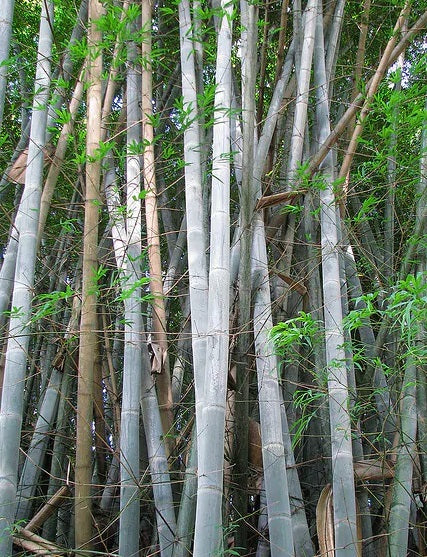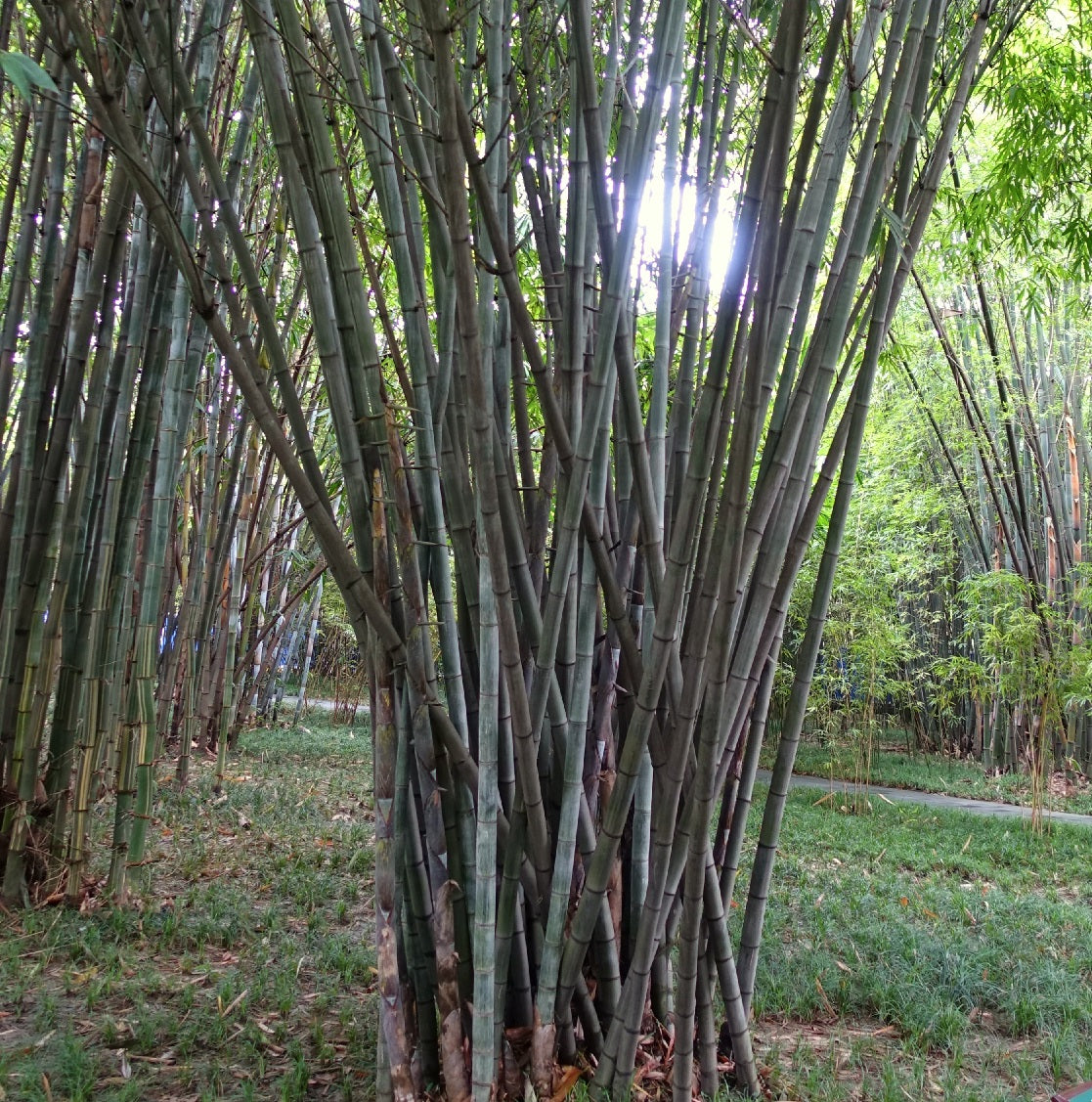Bamboo Seed Shop
Dendrocalamus membranaceus Bamboo Seeds
Dendrocalamus membranaceus Bamboo Seeds
Couldn't load pickup availability
Dendrocalamus membranaceus Bamboo Seeds for Sale
- Available in 100, 500, and 1000 bamboo seed counts
- Tropical
- Giant
- Clumping
- Cold Hardy to -1°C
- Height 8-15m
- Diameter 7-10cm
- Germination Rate 90%
About Waya Bamboo Seeds
Dendrocalamus membranaceus, commonly known as Waya Bamboo and Giant Membrane Bamboo, is a large and impressive bamboo species native to Southeast Asia. Here are the growth habits and appearance of Dendrocalamus membranaceus:
Size and Height: Dendrocalamus membranaceus is known for its exceptional height. It can grow up to 25-30 meters (82-98 feet) tall, making it one of the tallest bamboo species. The culms (stems) are thick and robust, typically with a diameter of around 15-20 centimeters (6-8 inches).
Culm Structure: The culms of Dendrocalamus membranaceus are sturdy and erect. They have prominent nodes (joints) along their length, from which branches, leaves, and buds emerge. The culms are green when young and gradually mature into a yellowish-brown color as they age.
Leaf Characteristics: The leaves of Dendrocalamus membranaceus are large and broad. They are typically lance-shaped, with a length of approximately 15-25 centimeters (6-10 inches). The leaves provide a lush and dense canopy when the bamboo plant is fully grown.
Growth Habit: Dendrocalamus membranaceus exhibits a clumping growth habit, forming dense clumps or groves of culms. The clumps gradually expand over time as new culms emerge from the common rhizome system. This growth habit allows for easier management and control of the bamboo's spread.
Culm Color: The culms of Dendrocalamus membranaceus are initially green when young. As they mature, they develop a yellowish-brown color, providing an aesthetically pleasing appearance.
Utilization: Dendrocalamus membranaceus has various practical applications. The large and sturdy culms are valued for construction purposes, including building materials, furniture, handicrafts, and flooring. The bamboo is also used in paper production, agricultural stakes, and as a source of edible shoots.
Climate and Growing Conditions: Dendrocalamus membranaceus thrives in warm tropical and subtropical climates. It prefers areas with average annual temperatures ranging from 20 to 35°C (68 to 95°F). The bamboo species requires well-drained soil, ample sunlight, and sufficient water for optimal growth.
It's important to note that specific growth habits and appearance can vary slightly depending on the growing conditions and geographic location of Dendrocalamus membranaceus bamboo.
Consider Dendrocalamus membranaceus bamboo seeds for moderate height and growth
Dendrocalamus membranaceus is not typically considered a giant bamboo species. It is a medium-sized bamboo species that can reach heights of around 10-20 meters (33-66 feet) and has culms with a diameter of approximately 5-10 centimeters (2-4 inches). While it is not classified as a giant bamboo, Dendrocalamus membranaceus is still a significant and useful bamboo species with various commercial applications.
The benefits of growing bamboo plants from bamboo seed
While growing bamboo from seeds may not be the most common method of propagation, there are some benefits to consider:
Genetic diversity: Growing bamboo from seeds can introduce genetic diversity within the cultivated bamboo population. This can be advantageous for breeding programs, research purposes, or for those interested in selecting unique traits and developing new cultivars. It allows for the exploration of variations in characteristics such as culm color, height, leaf shape, or growth habit.
Access to rare or exotic species: Some bamboo species or varieties may be rare or difficult to find as established plants. Growing bamboo from seeds provides an opportunity to cultivate and enjoy a wider range of bamboo species, including those that may not be readily available through other propagation methods. It can offer access to unique and lesser-known bamboo species.
Cost-effectiveness: Bamboo seeds are generally more affordable than purchasing established plants or rhizomes. Growing bamboo from seeds can be a cost-effective way to start a bamboo garden or plantation, especially when large quantities of plants are needed.
Educational value: Growing bamboo from seeds can be an educational endeavor, particularly for students, researchers, or enthusiasts interested in learning about plant propagation, botany, or horticulture. It provides a hands-on experience and a deeper understanding of the growth and development of bamboo plants.
Conservation and sustainability: Growing bamboo from seeds contributes to the conservation and preservation of bamboo species. By cultivating bamboo plants from seeds, individuals can actively participate in the propagation and preservation of bamboo, ensuring its availability for future generations and contributing to the overall biodiversity of bamboo.
While growing bamboo from seeds may require more time and patience compared to vegetative propagation methods, it offers unique benefits such as genetic diversity, access to rare species, cost-effectiveness, educational value, and contributions to conservation efforts. These benefits make it an attractive option for certain enthusiasts, researchers, and those interested in exploring the full range of bamboo diversity.
Growing Bamboo from Bamboo Seeds Requires Patience
Patience is key when growing bamboo from seed. Bamboo seeds can have a long germination period, which can vary depending on the species. Some bamboo species may take several weeks, months, or even years to sprout. Therefore, it's important to have realistic expectations and be prepared to wait patiently during the germination process.
Here are a few reasons why patience is necessary when growing bamboo from seed:
Germination variability: Bamboo seeds can have variable germination rates. Not all seeds may sprout, and the germination time can vary among the seeds that do sprout. It's important to understand that each seed may have its own timeline for germination.
Germination requirements: Some bamboo species have specific germination requirements, such as scarification (breaking the seed coat dormancy) or stratification (exposing seeds to cold temperatures). Meeting these requirements can enhance germination success but may also prolong the germination period. Patience is necessary while providing the necessary conditions for successful germination.
Long germination period: Bamboo seeds, in general, have a longer germination period compared to many other plant species. It can take weeks, months, or even longer for bamboo seeds to sprout and develop into seedlings. This requires a patient and attentive approach throughout the germination process.
Time to maturity: Bamboo plants grown from seeds also require a considerable amount of time to reach maturity. It can take several years for bamboo plants to develop into mature specimens with established culms and full growth. Patience is necessary to allow the bamboo plants to go through their natural growth stages.
While growing bamboo from seed requires patience, the process can also be rewarding as you witness the growth and development of the plants from the earliest stages. It's important to provide the necessary care, maintain consistent conditions, and monitor the progress of the seeds during the germination period. By exercising patience and diligence, you can enjoy the journey of growing bamboo from seed and ultimately see the results of your efforts.

Dendrocalamus membranaceus Bambussamen zu verkaufen
- 100 Samen
- Tropisch
- Riese
- Verklumpung
- Winterhart bis -1°C
- Höhe 8–15 m (49 Fuß)
- Durchmesser 7–10 cm
- Keimrate 90 %
Riesenmembran-Bambussamen
Dendrocalamus membranaceus, allgemein bekannt als Riesenmembranbambus, ist eine große und beeindruckende Bambusart, die in Südostasien beheimatet ist. Hier sind die Wachstumsgewohnheiten und das Aussehen von Dendrocalamus membranaceus:
Größe und Höhe: Dendrocalamus membranaceus ist für seine außergewöhnliche Größe bekannt. Er kann bis zu 25–30 Meter (82–98 Fuß) hoch werden und ist damit eine der höchsten Bambusarten. Die Halme (Stängel) sind dick und robust, typischerweise mit einem Durchmesser von etwa 15–20 Zentimetern (6–8 Zoll).
Halmstruktur: Die Halme von Dendrocalamus membranaceus sind robust und aufrecht. Sie haben entlang ihrer Länge markante Knoten (Gelenke), aus denen Zweige, Blätter und Knospen hervorgehen. Die Halme sind in jungen Jahren grün und reifen mit zunehmendem Alter allmählich zu einer gelblich-braunen Farbe heran.
Blattmerkmale: Die Blätter von Dendrocalamus membranaceus sind groß und breit. Sie sind typischerweise lanzenförmig und etwa 15 bis 25 Zentimeter lang. Die Blätter bilden ein üppiges und dichtes Blätterdach, wenn die Bambuspflanze ausgewachsen ist.
Wuchsform: Dendrocalamus membranaceus weist eine klumpige Wuchsform auf und bildet dichte Büschel oder Halmhaine. Die Büschel dehnen sich im Laufe der Zeit allmählich aus, wenn aus dem gemeinsamen Rhizomsystem neue Halme entstehen. Diese Wuchsform ermöglicht eine einfachere Verwaltung und Kontrolle der Ausbreitung des Bambus.
Halmfarbe: Die Halme von Dendrocalamus membranaceus sind in jungen Jahren zunächst grün. Mit zunehmender Reife entwickeln sie eine gelblich-braune Farbe und sorgen für ein ästhetisch ansprechendes Aussehen.
Verwendung: Dendrocalamus membranaceus hat verschiedene praktische Anwendungen. Die großen und robusten Halme werden für Bauzwecke geschätzt, darunter für Baumaterialien, Möbel, Kunsthandwerk und Fußböden. Der Bambus wird auch zur Papierherstellung, für landwirtschaftliche Pfähle und als Quelle essbarer Triebe verwendet.
Klima und Wachstumsbedingungen: Dendrocalamus membranaceus gedeiht in warmen tropischen und subtropischen Klimazonen. Es bevorzugt Gebiete mit durchschnittlichen Jahrestemperaturen zwischen 20 und 35 °C (68 bis 95 °F). Für ein optimales Wachstum benötigt die Bambusart gut durchlässigen Boden, viel Sonnenlicht und ausreichend Wasser.
Es ist wichtig zu beachten, dass spezifische Wachstumsgewohnheiten und Aussehen je nach Wachstumsbedingungen und geografischer Lage des Dendrocalamus membranaceus-Bambus leicht variieren können.
Erwägen Sie Dendrocalamus membranaceus-Bambussamen für mäßige Höhe und Wachstum
Dendrocalamus membranaceus gilt normalerweise nicht als Riesenbambusart. Es handelt sich um eine mittelgroße Bambusart, die eine Höhe von etwa 10–20 Metern (33–66 Fuß) erreichen kann und Halme mit einem Durchmesser von etwa 5–10 Zentimetern (2–4 Zoll) aufweist. Obwohl Dendrocalamus membranaceus nicht als Riesenbambus klassifiziert wird, ist er dennoch eine bedeutende und nützliche Bambusart mit verschiedenen kommerziellen Anwendungen.
Die Vorteile des Anbaus von Bambuspflanzen aus Bambussamen
Obwohl der Anbau von Bambus aus Samen möglicherweise nicht die gebräuchlichste Vermehrungsmethode ist, gibt es einige Vorteile, die es zu berücksichtigen gilt:
Genetische Vielfalt: Der Anbau von Bambus aus Samen kann zu genetischer Vielfalt innerhalb der kultivierten Bambuspopulation führen. Dies kann für Züchtungsprogramme, Forschungszwecke oder für diejenigen von Vorteil sein, die an der Auswahl einzigartiger Merkmale und der Entwicklung neuer Sorten interessiert sind. Es ermöglicht die Untersuchung von Variationen in Merkmalen wie Halmfarbe, Höhe, Blattform oder Wuchsform.
Zugang zu seltenen oder exotischen Arten: Einige Bambusarten oder -sorten sind möglicherweise selten oder als etablierte Pflanzen schwer zu finden. Der Anbau von Bambus aus Samen bietet die Möglichkeit, ein breiteres Spektrum an Bambusarten zu kultivieren und zu genießen, auch solche, die mit anderen Vermehrungsmethoden möglicherweise nicht ohne weiteres erhältlich sind. Es bietet Zugang zu einzigartigen und weniger bekannten Bambusarten.
Kosteneffizienz: Bambussamen sind im Allgemeinen günstiger als der Kauf etablierter Pflanzen oder Rhizome. Der Anbau von Bambus aus Samen kann eine kostengünstige Möglichkeit sein, einen Bambusgarten oder eine Bambusplantage anzulegen, insbesondere wenn große Mengen an Pflanzen benötigt werden.
Pädagogischer Wert: Der Anbau von Bambus aus Samen kann ein lehrreiches Unterfangen sein, insbesondere für Studenten, Forscher oder Enthusiasten, die sich für Pflanzenvermehrung, Botanik oder Gartenbau interessieren. Es bietet eine praktische Erfahrung und ein tieferes Verständnis des Wachstums und der Entwicklung von Bambuspflanzen.
Erhaltung und Nachhaltigkeit: Der Anbau von Bambus aus Samen trägt zur Erhaltung und Erhaltung der Bambusarten bei. Durch den Anbau von Bambuspflanzen aus Samen können sich Einzelpersonen aktiv an der Vermehrung und Erhaltung des Bambus beteiligen, seine Verfügbarkeit für künftige Generationen sicherstellen und zur gesamten Artenvielfalt des Bambus beitragen.
Während der Anbau von Bambus aus Samen im Vergleich zu vegetativen Vermehrungsmethoden möglicherweise mehr Zeit und Geduld erfordert, bietet er einzigartige Vorteile wie genetische Vielfalt, Zugang zu seltenen Arten, Kosteneffizienz, pädagogischen Wert und Beiträge zu Naturschutzbemühungen. Diese Vorteile machen es zu einer attraktiven Option für bestimmte Enthusiasten, Forscher und diejenigen, die die gesamte Vielfalt der Bambusvielfalt erkunden möchten.
Share



